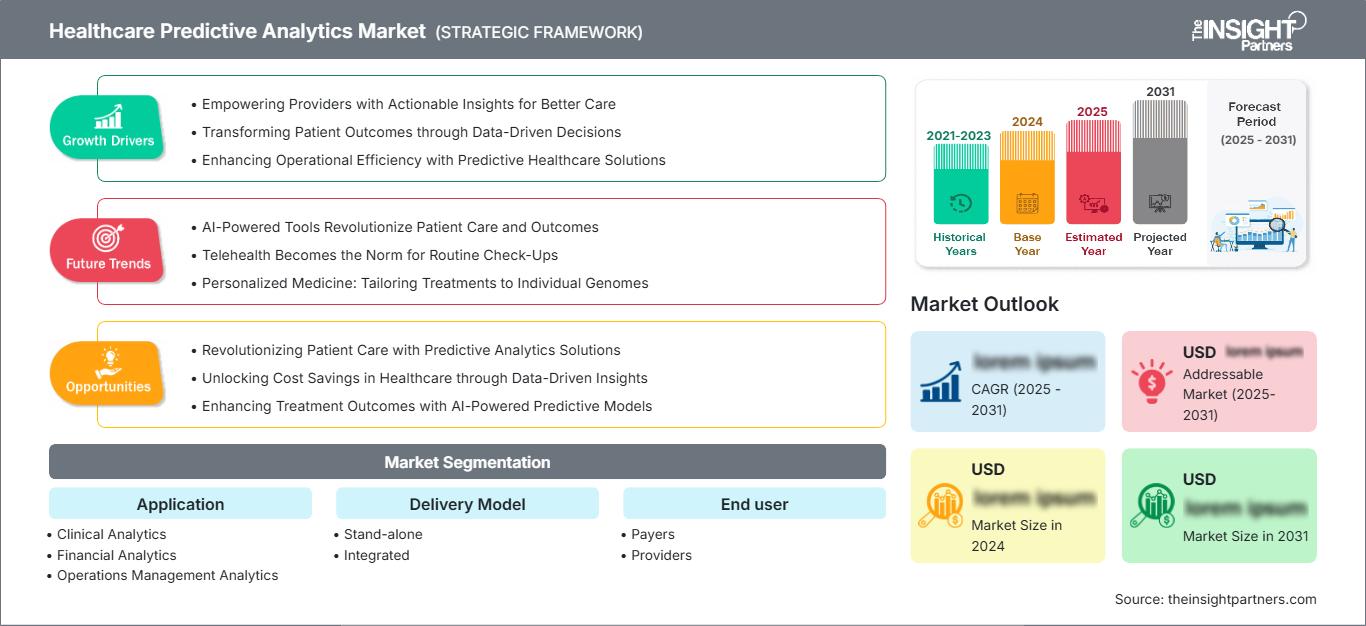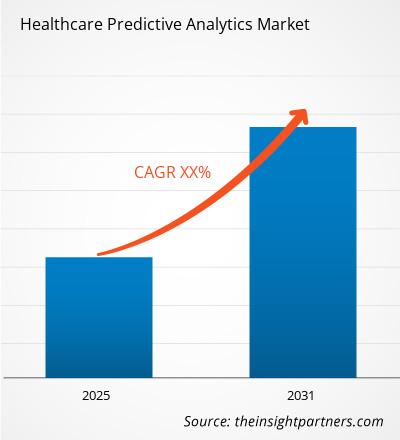Der Markt für prädiktive Analysen im Gesundheitswesen wird bis 2031 voraussichtlich ein Volumen von 113,61 Milliarden US-Dollar erreichen. Für den Zeitraum 2025–2031 wird ein jährliches Wachstum von 22,7 % erwartet.
Der Bericht ist nach Anwendungsbereichen (Klinische Analysen, Finanzanalysen, Analysen im operativen Management, Analysen im Bevölkerungsgesundheitsmanagement) kategorisiert und analysiert den Markt zudem nach Bereitstellungsmodell (Standalone, Integriert). Er untersucht den Markt auch nach Endnutzer (Kostenträger, Leistungserbringer). Für jedes dieser Schlüsselsegmente wird eine umfassende Aufschlüsselung auf globaler, regionaler und Länderebene bereitgestellt. Der Bericht enthält Marktgrößen und Prognosen für alle Segmente, angegeben in US-Dollar. Er liefert außerdem wichtige Statistiken zum aktuellen Marktstatus führender Akteure sowie Einblicke in vorherrschende Markttrends und neue Chancen.
Zweck des Berichts
Der Bericht „Markt für prädiktive Analysen im Gesundheitswesen“ von The Insight Partners beschreibt die aktuelle Marktlage und das zukünftige Wachstum sowie die wichtigsten Treiber, Herausforderungen und Chancen. Dies wird verschiedenen Akteuren im Geschäftsbereich Einblicke ermöglichen, wie beispielsweise:
- Technologieanbieter/Hersteller: Um die sich entwickelnde Marktdynamik zu verstehen und potenzielle Wachstumschancen zu erkennen, können sie fundierte strategische Entscheidungen treffen.
- Investoren: Um eine umfassende Trendanalyse hinsichtlich Marktwachstumsrate, Finanzprognosen und Chancen entlang der Wertschöpfungskette durchzuführen.
- Regulierungsbehörden: Um Richtlinien zu regulieren und Aktivitäten auf dem Markt zu überwachen, mit dem Ziel, Missbrauch zu minimieren, das Vertrauen der Anleger zu wahren und die Integrität und Stabilität des Marktes zu gewährleisten.
Anwendungssegmentierung des Marktes für prädiktive Analysen im Gesundheitswesen
- Klinische Analysen
- Finanzanalysen
- Analysen im Bereich Betriebsmanagement
- Analysen im Bereich Bevölkerungsgesundheitsmanagement
Bereitstellungsmodell
- Standalone
- Integriert
Endnutzer
- Kostenträger
- Leistungserbringer
Sie erhalten kostenlos Anpassungen an jedem Bericht, einschließlich Teilen dieses Berichts oder einer Analyse auf Länderebene, eines Excel-Datenpakets sowie tolle Angebote und Rabatte für Start-ups und Universitäten.
Markt für prädiktive Analysen im Gesundheitswesen: Strategische Einblicke

- Holen Sie sich die wichtigsten Markttrends aus diesem Bericht.Dieses KOSTENLOSE Beispiel umfasst Datenanalysen, die von Markttrends bis hin zu Schätzungen und Prognosen reichen.
Wachstumstreiber des Marktes für prädiktive Analysen im Gesundheitswesen
- Anbieter mit umsetzbaren Erkenntnissen für eine bessere Versorgung ausstatten
- Patientenergebnisse durch datengestützte Entscheidungen verbessern
- Betriebliche Effizienz durch prädiktive Gesundheitslösungen steigern
Zukunftstrends des Marktes für prädiktive Analysen im Gesundheitswesen
- KI-gestützte Tools revolutionieren Patientenversorgung und -ergebnisse
- Telemedizin wird zum Standard für Routineuntersuchungen
- Personalisierte Medizin: Behandlungen an das individuelle Genom anpassen
Marktchancen für prädiktive Analysen im Gesundheitswesen
- Patientenversorgung durch prädiktive Analyselösungen revolutionieren
- Kosteneinsparungen im Gesundheitswesen durch datengestützte Erkenntnisse erzielen
- Behandlungsergebnisse durch KI-gestützte prädiktive Analysen verbessern Modelle
Markt für prädiktive Analysen im Gesundheitswesen
Die regionalen Trends und Einflussfaktoren auf den Markt für prädiktive Analysen im Gesundheitswesen während des gesamten Prognosezeitraums wurden von den Analysten von The Insight Partners ausführlich erläutert. Dieser Abschnitt behandelt außerdem die Marktsegmente und die geografische Verteilung des Marktes für das Management von Herzrhythmusstörungen in Nordamerika, Europa, dem asiatisch-pazifischen Raum, dem Nahen Osten und Afrika sowie Süd- und Mittelamerika.
Umfang des Marktberichts zu prädiktiver Analytik im Gesundheitswesen
| Berichtsattribut | Einzelheiten |
|---|---|
| Marktgröße in 2024 | US$ XX Billion |
| Marktgröße nach 2031 | US$ 113.61 Billion |
| Globale CAGR (2025 - 2031) | 22.7% |
| Historische Daten | 2021-2023 |
| Prognosezeitraum | 2025-2031 |
| Abgedeckte Segmente |
By Anwendung
|
| Abgedeckte Regionen und Länder | Nordamerika
|
| Marktführer und wichtige Unternehmensprofile |
|
Dichte der Akteure im Markt für prädiktive Analysen im Gesundheitswesen: Auswirkungen auf die Geschäftsdynamik
Der Markt für prädiktive Analysen im Gesundheitswesen wächst rasant, angetrieben durch die steigende Nachfrage der Endnutzer. Gründe hierfür sind unter anderem sich wandelnde Verbraucherpräferenzen, technologische Fortschritte und ein wachsendes Bewusstsein für die Vorteile des Produkts. Mit steigender Nachfrage erweitern Unternehmen ihr Angebot, entwickeln innovative Lösungen, um den Bedürfnissen der Verbraucher gerecht zu werden, und nutzen neue Trends, was das Marktwachstum zusätzlich beflügelt.

- Holen Sie sich die Markt für prädiktive Analysen im Gesundheitswesen Übersicht der wichtigsten Akteure
Wichtigste Verkaufsargumente
- Umfassende Abdeckung: Der Bericht bietet eine umfassende Analyse der Produkte, Dienstleistungen, Typen und Endnutzer des Marktes für prädiktive Analysen im Gesundheitswesen und vermittelt so ein ganzheitliches Bild.
- Expertenanalyse: Der Bericht basiert auf dem fundierten Wissen von Branchenexperten und Analysten.
- Aktuelle Informationen: Der Bericht gewährleistet Geschäftsrelevanz durch die Berücksichtigung aktueller Informationen und Datentrends.
- Anpassungsmöglichkeiten: Dieser Bericht kann an spezifische Kundenanforderungen angepasst werden und sich optimal in die Geschäftsstrategien integrieren.
Der Forschungsbericht zum Markt für prädiktive Analysen im Gesundheitswesen kann somit maßgeblich dazu beitragen, das Branchenszenario und die Wachstumsaussichten zu entschlüsseln und zu verstehen. Auch wenn einige berechtigte Bedenken bestehen, überwiegen die Vorteile dieses Berichts insgesamt die Nachteile.
- Historische Analyse (2 Jahre), Basisjahr, Prognose (7 Jahre) mit CAGR
- PEST- und SWOT-Analyse
- Marktgröße Wert/Volumen – Global, Regional, Land
- Branchen- und Wettbewerbslandschaft
- Excel-Datensatz
Aktuelle Berichte
Verwandte Berichte
Erfahrungsberichte
Grund zum Kauf
- Fundierte Entscheidungsfindung
- Marktdynamik verstehen
- Wettbewerbsanalyse
- Kundeneinblicke
- Marktprognosen
- Risikominimierung
- Strategische Planung
- Investitionsbegründung
- Identifizierung neuer Märkte
- Verbesserung von Marketingstrategien
- Steigerung der Betriebseffizienz
- Anpassung an regulatorische Trends




















 Kostenlose Probe anfordern für - Markt für prädiktive Analysen im Gesundheitswesen
Kostenlose Probe anfordern für - Markt für prädiktive Analysen im Gesundheitswesen